This website is supported by its readers. If you click one of my links I may earn a commission. I am also a participant in the Amazon affiliates program and I will also earn a commission from qualified purchases.
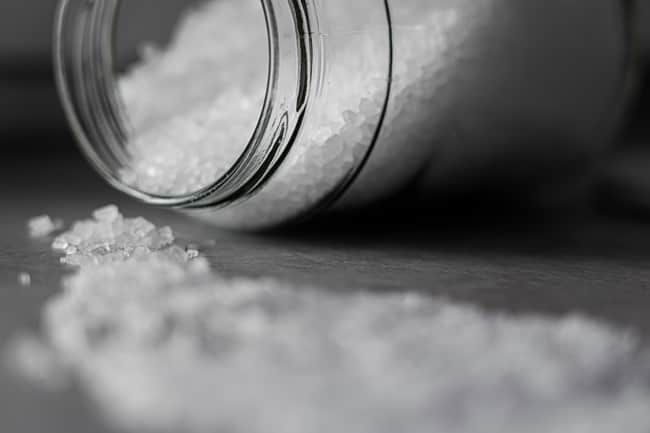
Chinese Elm trees are among one the most versatile tree species out there. They make for fantastic bonsai trees, but they can also be kept both in indoor and outdoor conditions. If grown in the wild, however, they can cause severe damage. A common question I had was how to kill a Chinese Elm tree, and more specifically, does salt kill a Chinese Elm tree?
Salt will kill Chinese Elm trees. The sodium ions contained in the salt prevent a Chinese Elm tree’s roots from absorbing potassium and magnesium through the soil, killing the tree. Mix the salt with water or use Saltpeter (Potassium Nitrate) for best results.
So what is the exact step-by-step method of using salt to kill Chinese Elm trees? And are there any better methods to kill Chinese Elm trees than using salt? Keep reading to find out more!
Just a quick heads up, over the past three years of running Plantpaladin, hundreds of people have asked for product recommendations. As such, You can find my favorite indoor bonsai tree here (link takes you to Bonsaiboy), my favorite outdoor bonsai tree (link takes you to Bonsaiboy), or have a look at all the products I recommend here.
Does salt kill Chinese Elm trees?
For that long-term reader of the blog, you will know that recently I moved house from a small apartment to my very own home.
As I was moving my bonsai collection outside in the back garden, I noticed a large Elm tree in the back.
While I was going to leave it be, I knew that Dutch Elm disease is rife, and with this Chinese Elm placed precariously close to the fence, I shared with my neighbor I thought it would be easier to kill the tree.
While I was going to hire a professional to kill this Chinese Elm, I thought I would bite the bullet and undertake the task myself.
One standard method I’ve heard about then is using salt to kill Chinese Elm trees.
I got in touch with a few tree experts, visited my local botanical gardens, and even undertook a quick survey of plant paladin readers and asked them if salt kills Chinese Elm trees?
All to ensure you have the best post on the web covering the topic.
To summarize:
- Salt will kill Chinese Elm trees.
- You will require a large amount of salt mixed with water to create a diluted solution.
- Chop your Chinee Elm until only a stump is left.
- Then drill in several holes and pour the saline solution into the holes.
- The Sodium ions in the salt will work their way down the tree through the roots.
- When in contact with the roots, they will cut off the supply of potassium and magnesium the tree can absorb through its roots, killing the tree.
- Regular table salt, rock salt, or pink salt can all be used for this; Saltpeter can also be used to kill your tree.
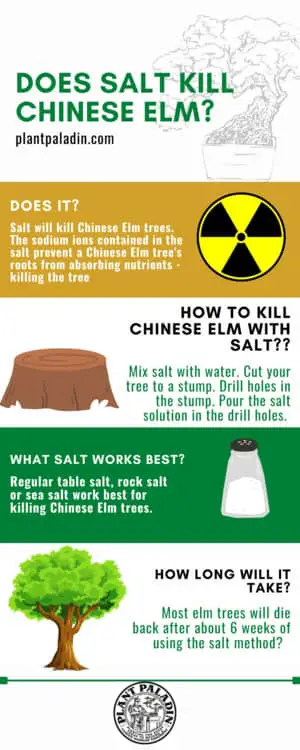
Let’s explore this in more detail:
Why does salt kill Chinese Elm trees?
So now we know that salt kills Chinese Elm trees; what exactly causes it to be so effective against rouge Elms growing in our gardens?
As many of you already know, plants use nutrients found in the soil to help manage the processes of photosynthesis.
Salt contains sodium ions.
These ions are microscopic particles (usually atoms or molecules) that hold an electric charge.
Now, when used near organic trees and plants, these ions inhibit the flow of magnesium and potassium into a Chinese Elm tree root.
Magnesium and potassium are both essential minerals needed for your tree.
Magnesium opens up the tiny holes in your Chinese Elm tree leaves to help them absorb Carbon Dioxide.
Potassium is used for general plant growth and is a vital element used in photosynthesis.
The sodium ion in salt will prevent your tree’s roots from absorbing these vital elements killing your tree at the core.
Salt will prevent your Chinese Elm from growing again instead of other chemical tree killers that can kill your Chinese Elm, but not at the root.
How to kill a Chinese Elm tree with salt?
While it might sound complex, the truth is that killing a Chinese Elm tree, or any Elm subspecies for that matter, is a relatively straightforward process.
Salt has been used historically for thousands of years to kill plant growth and has been coined salting the earth.
So if roman soldiers 2000 years ago can do this – I’m sure we can do it with no problem!
To kill a Chinese Elm tree with salt, then:
Gather your items
Before killing our Chinese Elm tree, you need to gather the relevant items.
I strongly suggest then that you invest in the following – the links will take you to amazon when you click on them:
- A Chainsaw or sharp ax to cut your tree to a stump.
- Protective eyewear
- Thick gloves
- A Drill
- 1 to a 1.5-inch drill bit
- Salt of your choice
- Vinegar
- Water
- A bottle
- A funnel
Chop your Chinese Elm to a stump
Many of you reading this will still have a standing Chinese Elm tree.
Our first step will be to cut this down to size to make it more manageable to work.
Use either a chainsaw or strong ax and cut your Chinese Elm tree until you have a stump of 8 to 10 inches.
To do so, make a horizontal cut at a comfortable height in your Chinese Elm tree.
Then make a second cut at a 45-degree angle on top of the first horizontal cut.
This cut will form a wedge on the side of the tree.
Make one final cut on the other side of the tree deep enough into the tree but ensure this does not cut meet the other cuts.
The Chinese Elm will then gently fall.
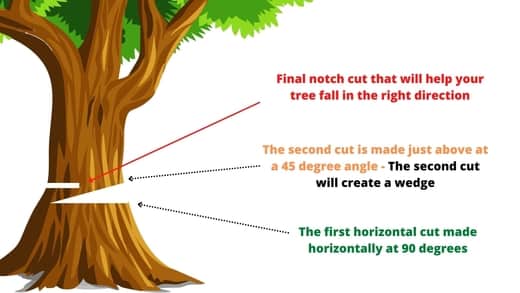
You might need to clean up any lower branches growing from the tree but doing so will make the rest of the steps a lot easier to manage.
If your tree is giant, say above 15 feet, then start by removing the branches at the bottom and slowly work your way up.
If your Chinese Elm tree is more petite, used for bonsai, remove the branches with a branch cutter which I found works for most bonsai trees.
Prepare your salt solution.
Now that your Chinese Elm tree has been transformed into a stump, it’s time to prepare the salt.
While some people might recommend using salt raw, I find that mixing salt with water will allow the solution to penetrate the hard-to-reach areas of a Chinese Elm tree’s roots.
Chinese Elm is incredibly versatile and challenging to kill, and sometimes some can survive even when most of the roots they use are dead.
Using a salt and water solution will ensure an even distribution of coverage across your roots.
Use two parts of water and one part of salt to kill your tree.
For example, for an enormous Chinese Elm tree that is 15 feet tall, I would consider using get 6 cups of salt (768 grams) and mix with 1 liter of water.
The salt concentration must be high to prevent the salt from diluting or losing its strength.
Then put this solution in a flask or bottle that is easily pourable.
Consider using a funnel to prevent your mixture from spilling out and damaging surrounding grass and trees.
Drill holes in the stump
Now time for the fun part!
Using your drill, attach a drill bit with either a one-inch or one-and-a-half-inch head to drill the same sized hole circumference.
Then drill 6 to 10 holes at a slanted angle – this will help the solution penetrate the stump more easily.
These holes should be evenly spaced around the perimeter of your tree stump.

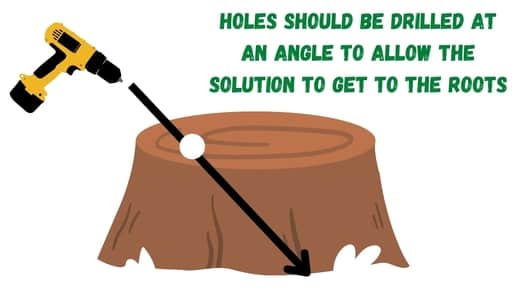
Aim for these drill holes to be between 6 and 10 inches deep.
These holes will typically be deep enough to penetrate your tree’s root structure.
Pour in the solution.
Finally, pour in the solution you made earlier in the drill holes.
Place a funnel in the one-inch hole to prevent this from damaging the surrounding flora next to your Chinese Elm.
Then pour the solution into each of the holes evenly.
How much salt should you pour in the holes?
The exact amount of salt and water solution your pour into each of the drill holes will vary depending on the size of your Chinese Elm.
More oversized Chinese Elm will need four liquid ounces or 100ml in each hole made by your drill.
Smaller Chinese Elm trees will require a lot less with fingertip-sized Chinese Elm use for bonsai only needed 10ml or less of the salt solution per hole.
How many times will you have to repeat the process?
This process will only need to be undertaken once to kill your Chinese Elm tree for most smaller Chinese Elm trees.
For more giant Chinese Elm trees that are, say, over 1.5 meters tall, this process may need to be repeated 3 or 4 times until the tree dies.
This process will typically start with your tree looking shriveled, it losing leaves before eventually dying off.
Remove the stump
So after a few weeks, the Chinese Elm will be dead.
It would be a good idea to remove the dead stump from the tree to avoid insects and other bigs decomposing the stump – which can sometimes lead to a foul smell or many bugs in your back yard.
To do so, use a shovel and dig up the stump.
The roots should be shriveled and not too challenging as the tree is dry.
Place in a wheelbarrow and transport to your local garden waste center.
How long does it take to kill Chinese Elm trees using salt?
Chinese Elm trees will typically take six weeks to die if salt is used to kill the tree. A Chinese Elm tree will start to wilt and lose branches within the first two weeks. After a month, the Chinese Elm roots will begin to loosen.
In the last two weeks, you should easily be able to pick up the Chinese Elm tree stump and discard it.
Pouring the salt/water solution into the Chinese Elm tree, however, might need to be repeated a few times for the best results.
Will salt kill other Elm trees?
Salt will kill Chinese Elm trees and all other Elm tree sub-species. Salt is effective at killing most plant and tree species alike and has been used historically for years to scratch the earth that trees grow on.
Problems with using salt to kill a Chinese Elm
While salt is fantastic at killing Chinese Elm trees, there are a few significant downsides to using it to destroy your tree.
These include:
Kill other plant life.
If you keep other trees, plants, or grass near your Chinese Elm tree and you want to use the salt method, it is super essential you move them out the way first.
Salt will destroy the minerals in the soil that are vital to your Chinese Elm tree survival.
If the grass, plants, and other leaves get nutrients in and around your Chinese Elm tree, you risk killing these trees in the process.
It’s very much a case of throwing the baby out with the bathwater, so ensure you either move your plants away from your Chinese Elm or only use salt if you do not care about the surrounding flora near your tree.
Salt can also be hazardous to insects and mollusks like Slugs and Snails, so be careful when using it.
A lot of salt is needed.
Even if you have a relatively small Chinese Elm tree, a lot of salt will be required to kill the tree.
The typical ratio is two parts water to one part salt, but even if you have a small tree, it is not uncommon for anywhere between 100g to 1kg of salt to be used to kill your tree.
Alternatively, if you have a much larger Chinese Elm tree that is larger than two meters tall, more salt will need to be used.
More effective methods
Finally, the last major downside to using salt to kill Chinese Elm is that while it can work, more effective methods can be used.
Herbicides, Tordon, girdling, and copper nails can all produce better results faster when compared to killing Chinese Elm trees than using traditional salt.
If you are in a hurry, then consider using one of the other options on this list.
Which salt works best for killing Chinese Elm trees?
Regular table salt, sea salt, rock salt, or Saltpeter are the best salt types to kill a Chinese Elm tree. Mix with water, drill holes in your tree stump, and pour in the solution.
Why do Chinese Elm trees need to be killed?
Some Chinese Elm trees need to be killed because of Dutch Elm disease. Dutch Elm disease is an infectious disease that, if left unchecked, can spread to other plants and cause severe problems to surrounding Flora.
When Chinese Elm trees also get infected with common pests such as Aphids, Spider-mites, Scale, and Caterpillars sometimes, it is better to kill a Chinese Elm than let the insects spread to other trees and plants in your collection.
Chinese Elm also produces many seeds that mature and fall to the ground.
These seeds are very easily propagated and increase if left unchecked.
As such, population control is required to prevent these trees from overpopulation.
Other methods to kill Chinese Elm trees
So while salt is incredibly effective against killing Chinese Elm trees, a few other methods highlighted earlier are as good, if not more effective at killing Chinese Elm trees.
These include:
- Herbicides
- Tordon
- Girdling
- Copper Nails
Let’s explore these in more detail:
Herbicides
While salt can be a fantastic natural alternative to killing Chinese Elm trees, traditional herbicides can work very well if you don’t mind using chemicals.
Depending on your Chinese Elm’s size, you may need to use different methods to kill the tree.
If your tree trunk is less than 4 inches in diameter, use a herbicide containing triclopyr.
Depending on the herbicide, this will be ready to use directly from the bottle or a solution you need to mix with Diesel Fuel.
If you need to mix your herbicide, do so with one part herbicide to 5 parts diesel.
Then gently pour into a sprayer or backpack sprayer, and spray the bottom 12 inches of the tree, nearest the base soil.
Spray until dripping wet, and the Chinese Elm should die after a few weeks.
What if my tree is larger?
If your Chinese Elm tree is more prominent, Cut your tree down to a stump like you would using the salt method.
The spray with the herbicide, and after a few weeks, the tree should die.
Tordon
One particular type of herbicide that I find worked very well at killing Chinese Elm trees, in particular, is Tordon.
Tordon is typically ready to use, meaning you won’t have to mix it with other chemicals or agents, and best of all, it contains Picloram, which is non-toxic to people, mammals, birds, and bees.
To use, then cover yourself in protective gear. While this is safe to be used by humans, it will sting if it gets in your eyes, so be careful.
Cut your Chinese Elm tree down to a stump as you would for the salt method.
Then gently pour the Tordon on the stump until it is wet.
You can then cover it with a plastic bag to prevent you from touching it or rainwater washing the Tordon away.
After a few weeks, the stump will have died.
You can then dig up the stump and remove it.
Girdling
Girdling is a method that has been used for thousands of years to kill off or “die back trees.”
It is also very effective against Chinese Elm trees.
To use, find a section of your tree trunk that is about chest high.
Ensure this area is smooth and has no branches or knots on it.
Use a pry bar to remove a section of bark until you get to the inner bark.
Then remove the rest of the bark on the tree’s trunk until you have removed about 10 inches tall around the circumference of the tree.
Thighs will block the flow of nutrients to the leaves, which will prevent photosynthesis from taking place, killing your tree.
I’d recommend having a look at the video below for the best results:
Copper nails
Finally, copper nails also work very well at killing Chinese Elm trees.
To use, cut your Chinese Elm tree back to a stump.
Then place 6 to 8 copper nails in the trunk, spaced about 1 inch apart.
These nails will then oxidize over time, poisoning the Chinese Elm trees after a few weeks.
Once your tree is dead, remove the tump and ensure you also remove the copper nails, which can further poison surrounding areas.
Survey on does salt kill Chinese Elm trees?
Finally, I quickly surveyed ten plant paladin readers who killed their Chinese Elm trees if salt was effective.
Here are the results:
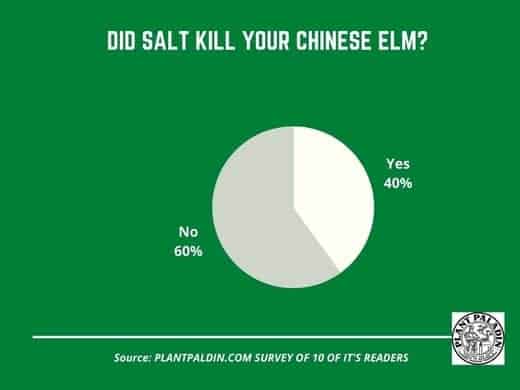
Now Chinese Elm is one of the more popular indoor tree species. Hopefully, you might find the following posts helpful:
My top picks for the gear you will need!
So like I mentioned earlier, over the past three years of running PlantPaladin, hundreds of people have asked me for my recommendations on the best bonsai gear on the market.
Having spent thousands of dollars on bonsai items these past few years and tested at least 100 bonsai-specific products, I’ve listed my favorite products below – All of which I highly recommend and think you can get great value.
They can purchase directly by clicking the link to take them to Amazon.
Bonsai Tool Set: One of the significant challenges I’ve had is finding a toolset that was not only durable but didn’t break the bank. SOLIGT has recently developed a fantastic bonsai tool set that covers all the tools you need to trim, prune, and repot your trees. – You can grab it here.
Complete Bonsai Set: Many of you will want to grow your bonsai trees entirely from scratch, but finding the varicose seeds, pots, and other items in one place can be challenging. Leaves and Sole then have created a complete bonsai set that I’ve personally used that ticks all the boxes. You can grab it here.
Bonsai wire: The number of times I’ve run out of wire for my bonsai or purchased cheap bonsai wire that doesn’t do the job is embarrassing for me to admit. After a lot of trial and error, I found that using Hotop’s aluminum bonsai wire is one of the best options on the market. This can easily be used for both indoor and outdoor bonsai. You can grab it here.
This post was written by Fehed Nicass who has been passionate about bonsai for over 3 years. He currently resides in the UK and works in sales.
